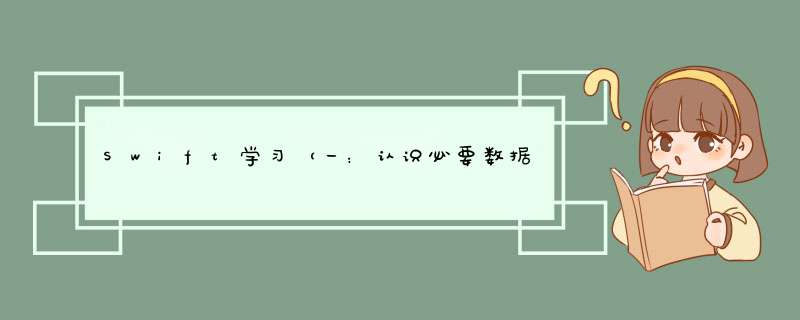
<span >如果你看到这篇文章,说明你有学IOS开的的强烈愿望。</span>
我很高兴为你讲解我的学习过程。首先,你会问为什么不选择ObjC而是Swift,我想这个问题只有苹果自己知道,我们只有猜。不过从代码结构上来看Swift确实比OC简洁多了,Swift省掉那些OC难以理解的符号,比如NSLog传递消息时是这么写的:NSLog(@"You code in here"); 学过C#的Programmer应该认识这个@,在OC中我不知道怎么理解,所以就不管了。
那么现在我们就开始,yeah!首先,我强烈建议去买台MAC,也就一万左右。当然,如果你和我一样用的是咱们中国人撑起的windows,你可以和我一样装个虚拟就OK了。我的虚拟机是:VMware Workstation 12.1.0 + OS X EI CAPItan 10.11.2,请原谅我是一个强迫症患者,任何软件都要最新的。
关于如何安装XCode 7.2我就不说了,你去AppStore免费下就OK了!
注:我的笔记都以注释的方式在源码中呈现!!!
学习笔记开始
//// main.swift// hello word//// Created by YiSong on 12/10/15.// copyright © 2015 YiSong. All rights reserved.//import Foundationprint("------------Hello Word!-----------\n")// Variable 'number' used before being initialized.var number: Int?var number2: Int = 100number = 888print(number)print(number2)/*** End of every statement have a semicolon.*/let mConstant = 9;var mVariable = 1;mVariable = 6;print("Print mVarible and mConstant in string,mVarible:\(mVariable) mConstant:\(mConstant) \n");/*** End of every statement without semicolon.*/let label = "The wIDth is"let wIDth = 94let wIDthLabel = label + " " + String(wIDth)print(label)print(wIDthLabel + "\n")/*** Create arrays and dictionarIEs using barckets([]).*/var shopPingList = ["catfish","water","tulips","bulepaint"];shopPingList[1] = "apple";print(shopPingList);// you should notice,print() method can output a array.var occupations = [ "Malcolm" : "Captain","Kaylee" : "Mechainc",];occupations["Kaylee"] = "";occupations["Jayne"] = "Public Relations";print(occupations);print("\n");/*** Create an empty array or dictionary,use the initializer Syntax.*/var emptyStringArray = [String]()let emptyIntegerArray = [Int]()var emptyDictionary = [String : Double]()emptyStringArray.append("I'm append")print(emptyStringArray)emptyDictionary["price"] = 21.00print(emptyDictionary)var carList = []var studentInfo = [:]carList = emptyStringArrayprint(carList)studentInfo = emptyDictionaryprint(studentInfo)var optionalString: String? = "hello"print(optionalString == nil)// you should notice,keyword nil is equal to null.var optionalname: String? = "John Applseed"var greeting = "Hello!"if let name = optionalname { greeting = "Hello,\(name)"}print(greeting)let nickname: String? = nillet fullname = "John Appelseed"let infomalGreetin1 = "Hi \(nickname ?? fullname)"let infomalGreetin2 = "Hi \(nickname != nil ? nickname :fullname)"print(infomalGreetin1)print(infomalGreetin2)// switchlet vegetable = "red pepper"switch vegetable{case "celery": print("Add some raisins and make ants on a log.") // case "cucumber","watercress","red pepper": // print("That would make a good tea sanDWich.")case let x where x.hasSuffix("pepper"): print("Is it a sicpy \(x)")default:// Switch must be exhaustive,consIDer adding a default clause. print("Evertthing tastes good in soup.")}let interestingNumbers = [ "Prime" : [2,3,4,5,6,7],"Fibonacci" : [1,1,2,0],"Square" : [3,44,55,2]]var largest = 0// for-infor (kind,numbers) in interestingNumbers{ print(kind) print(numbers) for number in numbers{ //print(number) if (number > largest){ largest = number } }}print("The largest number is \(largest)")// whilevar m = 0while (m < 0){ m += 1;}print(m)// repeat-while like do-while in other program language.var n = 0;repeat{ n += 1;}while n < 0print(n)// using ..< to make a range.var sum = 0for i in 0..<10 { sum += i}print(sum)sum = 0for (var i = 0; i<10 ;i++) { sum += i}print(sum)// use func to declare a function. use -> to separate the parameter names and types from the function's return type.func greet(name : String,age : Int) -> String{ return "Hello \(name),your age is \(age)"}print(greet("YiSong",age: 22))// use a truple to make a compound value - for example,to return multiple values from a function. The elements of a tuple can be rither by name or by number.func calculateStatistics(scores : [Int]) -> (min : Int,max : Int,sum : Int,average: float){ var min = scores[0] var max = scores[0] var sum = 0 var average: float for score in scores{ if score < min{ min = score } if score > max{ max = score } sum += score } average = float(sum)/float(scores.count) return (min,max,sum,average)}// print(calculateStatistics([66,78,90,45,70,98,88,69,58]))let statistics = calculateStatistics([66,58])print("min score: \(statistics.min),max score: \(statistics.1),sum score:\(statistics.sum),average score:\(statistics.average))")// Functions can also take a variable number of argument,collecting them into an arrayfunc sumOf (numbers: Int...) -> Int{ var sum = 0 for number in numbers{ sum += number } return sum}print(sumOf())print(sumOf(23,56,67,90))// functions are first-class type. This means that a funxtion can return another function as its value.func makeIncrementer() -> ((Int) -> Int){ func addOne(number: Int) -> Int{ return number + 1; } return addOne}print(makeIncrementer()(8))// A function can take another function as one of its arguments.func hasAnyMatches(List: [Int],condition: (Int) -> Bool) -> (isMatche: Bool,List: [Int]){ var isMatche: Bool = false var lessthanTenList: [Int] = [] for item in List{ if condition(item){ isMatche = true lessthanTenList.append(item) } } return (isMatche,lessthanTenList)}func lessthanTen(number: Int) -> Bool{ return number < 10}var result = hasAnyMatches([20,34,12],condition: lessthanTen)print(result.isMatche)print(result.List)// closurevar numbers = [22,33,55]print(numbers.map({ (number: Int) -> Int in let result = 3 * number return result}))print(numbers.map({ number in 3 * number}))// rewrite the closure to return zero for odd numbersfunc isOddNumber(number: Int) -> Bool{ return number % 2 == 0 ? false : true}print(numbers.map({ (number: Int) -> Int in if isOddNumber(number){ return 0 }else{ return number }}))//When a closure is the only argument to a function,you can omit the parentheses entirely.print(numbers.sort{ > }) 总结 以上是内存溢出为你收集整理的Swift学习(一:认识必要数据类型)全部内容,希望文章能够帮你解决Swift学习(一:认识必要数据类型)所遇到的程序开发问题。
如果觉得内存溢出网站内容还不错,欢迎将内存溢出网站推荐给程序员好友。
欢迎分享,转载请注明来源:内存溢出

 微信扫一扫
微信扫一扫
 支付宝扫一扫
支付宝扫一扫
评论列表(0条)